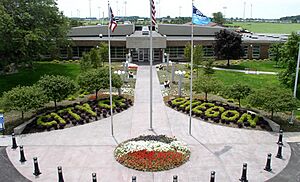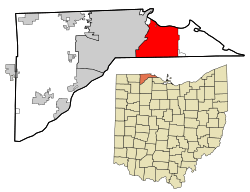Oregon, Ohio facts for kids
Quick facts for kids
Oregon, Ohio
|
|
|---|---|

Oregon Municipal Building
|
|
| Motto(s):
"Oregon on the Bay: City of Opportunity”
|
|

Location in Lucas County and the state of Ohio.
|
|
| Country | United States |
| State | Ohio |
| County | Lucas |
| Government | |
| • Type | Mayor-Council |
| Area | |
| • Total | 28.90 sq mi (74.85 km2) |
| • Land | 28.52 sq mi (73.87 km2) |
| • Water | 0.38 sq mi (0.98 km2) |
| Elevation | 594 ft (181 m) |
| Population
(2020)
|
|
| • Total | 19,950 |
| • Density | 699.46/sq mi (270.06/km2) |
| Time zone | UTC-5 (Eastern (EST)) |
| • Summer (DST) | UTC-4 (EDT) |
| ZIP codes |
43605, 43616, 43618
|
| Area code(s) | 419/567 |
| FIPS code | 39-58730 |
| GNIS feature ID | 1086529 |
| Website | https://www.oregonohio.org/ |
Oregon is a city in Lucas County, Ohio, United States. It is located on the shores of Lake Erie. Oregon is a suburb of Toledo, found just east of the larger city. It is also home to Maumee Bay State Park. In 2020, about 19,950 people lived in Oregon.
Contents
History of Oregon, Ohio
Oregon was once part of a huge swampy area called the Great Black Swamp. This swamp was full of many kinds of trees like oak, hickory, and maple. Because of all these trees, many sawmills were built, and people started to settle here.
From Swamp to Farmland
After the trees were cut down, the land became rich farmland. However, it was still very wet. So, people built large ditches, often along old Native American trails. These ditches still help drain rainwater into Maumee Bay today.
How Oregon Got Its Name
The town of Oregon was named by Pierre M. Irving in 1838. He was the nephew of a famous author, Washington Irving. Washington Irving wrote a popular book called Astoria. This book made many people interested in the Oregon Territory. Pierre Irving was working for a fur trading company in the area. He successfully suggested naming the new town "Oregon."
Early Government and Growth
The first local government was Oregon Township, created in 1838. The land was measured and sold to settlers. Today, the City of Oregon covers the same area as the old township. It is bordered by Toledo to the west and Lake Erie to the north. In 1856, the township took control of two cemeteries. The city still owns these cemeteries today.
Transportation and Industry
In the 1800s and 1900s, a large rail system was built. The Port of Toledo started operating in the early 1800s. In 1955, it expanded its operations to Maumee Bay in Oregon. These port activities are still important in the city's northwest area.
Because Oregon had good access to water, rail, and roads, two major oil refineries opened there. These were British Petroleum (BP) and Sun Marketing. They became two of the city's biggest employers. The northwest part of the city also grew as an industrial area. It had a power plant and chemical factories. Pipelines were built to move oil products to and from the port.
City Development and Services
As industries grew, more businesses and homes were built. The city generally expanded eastward from Interstate 280. This was one of the first major highways in the country. More recently, homes have also been built near the waterfront and in rural areas.
In 1954, leaders in Oregon Township wanted to set rules for land use. At the same time, Toledo officials tried to take over the industrial area of Oregon Township. This attempt failed. In 1957, people in Oregon voted to become an official city. The main reason for this was so Oregon could own and run its own water and wastewater plants.
The City of Oregon officially adopted its own rules in 1958. The new city's slogan became "City of Opportunity." In the mid-1980s, they added "Oregon on the Bay" to the slogan. In 1959, voters approved a local income tax. The city's water plant was built in 1964. Today, over 90% of Oregon's land has water lines. The city also has a wastewater treatment plant, built in 1977. It can clean up to eight million gallons of water each day. These plants also provide services to parts of nearby townships and counties.
A fun fact: The very first Marco's Pizza restaurant opened in Oregon in 1978!
City Officials
Here are some of the people who help run the City of Oregon:
| Office | Name | Party |
|---|---|---|
| Mayor | Michael J. Seferian | Independent |
| City Administrator | Joel L. Mazur | |
| Council President | Steve Hornyak | Republican |
| Council member | Paul Drake | Democrat |
| Terry Reeves | Democrat | |
| Steven Salander | Independent | |
| Dennis Walendzak | Democrat | |
| Beth Ackerman | Republican | |
| Kathleen Pollauf | Independent | |
| Chief of Police | Brandon Begin | |
| Fire Chief | Clayton O'Brien | |
| Director of Public Service | Paul Roman, P.E. | |
| Finance Director | Nick Roman |
Geography and Land Area
According to the United States Census Bureau, the City of Oregon covers about 38 square miles (98 square kilometers). Most of this area, about 30 square miles (78 square kilometers), is land. The remaining 8 square miles (20 square kilometers) is water.
Population and Demographics
| Historical population | |||
|---|---|---|---|
| Census | Pop. | %± | |
| 1960 | 13,319 | — | |
| 1970 | 16,563 | 24.4% | |
| 1980 | 18,682 | 12.8% | |
| 1990 | 18,334 | −1.9% | |
| 2000 | 19,355 | 5.6% | |
| 2010 | 20,291 | 4.8% | |
| 2020 | 19,950 | −1.7% | |
| 2021 (est.) | 19,865 | −2.1% | |
| Sources: | |||
Population in 2010
In 2010, there were 20,291 people living in Oregon. There were 8,196 households, which are groups of people living together. About 5,555 of these were families.
Most people in Oregon were White (93.5%). Other groups included African American (1.4%), Native American (0.2%), and Asian (0.8%). About 7.5% of the population was Hispanic or Latino.
The average age in the city was 42.3 years old. About 22.6% of residents were under 18 years old. About 17.6% were 65 years or older. The population was almost evenly split between males (48.1%) and females (51.9%).
Fun Attractions in Oregon
Oregon has several popular places to visit. One well-known spot is the Sundance Drive-In. It is one of the last drive-in movie theaters in the area.
Pearson Metropark is located within the city. Maumee Bay State Park is also nearby. Both parks have preserved parts of the original Great Black Swamp forest. Maumee Bay State Park also has a resort on Lake Erie. It features a golf course that has hosted many important tournaments.
Because Oregon is on major bird migration routes, many people come here to watch birds. Fishing and boating on Lake Erie are also popular activities. The city also has a large softball and baseball program for recreation. Each year, Oregon hosts a big German American festival. Over 30,000 people attend this event.
Education in Oregon
Students in Oregon attend schools that are part of the Oregon City School District. The district has three elementary schools, one intermediate school, one junior high school, and one high school. Clay High School offers special career and technology programs. These programs help students prepare for jobs right after high school.
Cardinal Stritch Catholic High School and Academy is also in Oregon. It was founded in 1960. The school is named after Cardinal Samuel Stritch, who was a bishop in Toledo.
Oregon also has a public library. It is located on Dustin Road and is a branch of the Toledo-Lucas County Public Library.
See also
 In Spanish: Oregon (Ohio) para niños
In Spanish: Oregon (Ohio) para niños



